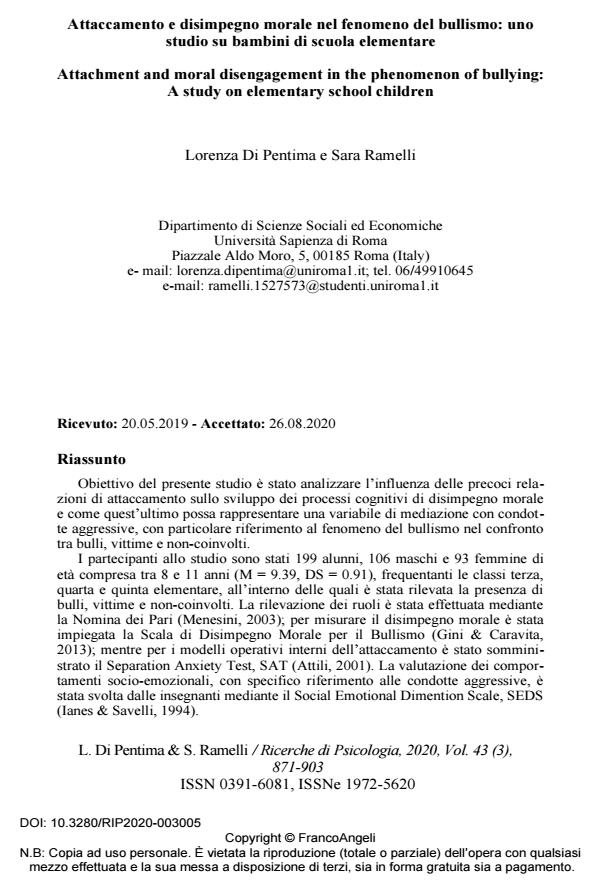Attachment and moral disengagement in the phenomenon of bullying: A study on elementary school children
Journal title RICERCHE DI PSICOLOGIA
Author/s Lorenza Di Pentima, Sara Ramelli
Publishing Year 2020 Issue 2020/3
Language Italian Pages 33 P. 871-903 File size 314 KB
DOI 10.3280/RIP2020-003005
DOI is like a bar code for intellectual property: to have more infomation
click here
Below, you can see the article first page
If you want to buy this article in PDF format, you can do it, following the instructions to buy download credits

FrancoAngeli is member of Publishers International Linking Association, Inc (PILA), a not-for-profit association which run the CrossRef service enabling links to and from online scholarly content.
Aim of this study was to analyze the influence of early attachment relationships on the development of cognitive processes concerning moral disengagement and how the latter can represent a mediation variable with aggressive behaviors, with particular reference to the phenomenon of bullying comparing bullies, victims and non-involved. Participants were 199 children, 106 males and 93 females aged between 8 and 11 years (M = 9.39, SD = 0.91), attending the third, fourth and fifth grade classes, in which the presence of bullies, victims and non-involved was detected. Instruments administered were: Peer Nomination (Menesini, 2003) for the roles of bullies, victims and non-involved; the Moral Disengagement Scale for Bullying as for the measurement of the moral disengagement (Gini & Caravita, 2013); and the Separation Anxiety Test (SAT) for the measurement of the mental models of attachment (Attili, 2001). Teachers assessed behavioral patterns by Social Emotional Dimension Scales, SEDS (Ianes & Savelli, 1994). The overall results highlight moral disengagement represents a mediator between insecure attachment and aggressive behavior. In the comparison between bullies, victims and non-involved, the former are not only more frequently insecure, but also report higher scores in moral disengagement and are evaluated as more aggressive by teachers.
Keywords: Attachment, moral disengagement, bullying, school age.
- Parenting Styles and Moral Disengagement in Young Adults: The Mediating Role of Attachment Experiences Lorenza Di Pentima, Alessandro Toni, Antonio Roazzi, in The Journal of Genetic Psychology /2023 pp.322
DOI: 10.1080/00221325.2023.2205451 - Attachment experiences and moral development: the mediating role of alexithymia and emotional regulation skills in a sample of young women Lorenza Di Pentima, Alessandro Toni, Antonio Roazzi, in Mind & Society /2025 pp.999
DOI: 10.1007/s11299-025-00334-z - Moral development and parenting styles: the mediating role of emotional skills Lorenza Di Pentima, Alessandro Toni, Antonio Roazzi, in Current Psychology /2024 pp.16674
DOI: 10.1007/s12144-023-05577-y
Lorenza Di Pentima, Sara Ramelli, Attaccamento e disimpegno morale nel fenomeno del bullismo: uno studio su bambini di scuola elementare in "RICERCHE DI PSICOLOGIA " 3/2020, pp 871-903, DOI: 10.3280/RIP2020-003005